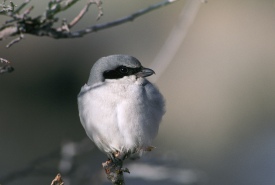
Eastern loggerhead shrike (Photo by Dave Menke, courtesy of USFWS)
Eastern loggerhead shrike
The loggerhead shrike, one of the fastest-declining bird species in North America, is a unique songbird. Canada has two subspecies — the prairie subspecies occurs in Saskatchewan and Alberta, and the eastern subspecies in Ontario and Quebec. The range of both overlaps in Manitoba. Don’t be fooled by its delicate appearance, though; the loggerhead shrike hunts like a bird of prey.
What does the eastern loggerhead shrike look like?
This songbird gets its name from its disproportionately large head that sits atop a small, delicate body. Similar to its cousin, the northern shrike, the eastern loggerhead shrike has a raccoon-like eye mask, grey back with black wings, white underparts and a small hook at the end of its bill. While both possess similar traits, the loggerhead shrike is distinguished by its wider eye mask, which covers both the entire eye and its bill, and a completely white underside with no markings.
Where does the eastern loggerhead shrike live?
Eastern loggerhead shrikes are migratory, wintering in the southern United States. Each spring, they return to Canada to breed in the grasslands of southern Ontario, Quebec and Manitoba. In these grasslands, they prefer to use trees with thorns, including hawthorns, to rear their young and take apart their prey.
What does the eastern loggerhead shrike eat?
Using its strong, hooked beak, the eastern loggerhead shrike cracks the skull or pecks at the neck of its prey — usually small mammals, insects and other birds — to deliver a fatal blow. As the shrike does not possess the strong grasping talons of a raptor, it cannot hold its prey while it eats, so it has a creative solution to this problem. Using the sharpness of thorns and barbed wires as a “skewer,” the shrike can hold its prey in place while eating or leave the critter there for future consumption.
What is the eastern loggerhead shrike's conservation status?
The Committee on the Status of Endangered Wildlife in Canada has assessed the eastern loggerhead shrike as endangered in Canada. Loss of grassland ecosystems through natural succession and continuous human impact — in the form of climate change, agriculture and use of pesticides — have destroyed many grassland habitats that the eastern loggerhead shrike depends on in Ontario, Quebec and Manitoba. In Canada, there are now less than 110 adults of this subspecies.
What is NCC doing to protect the eastern loggerhead shrike's habitat?
To protect any existing populations and to restore any potential populations, the Nature Conservancy of Canada (NCC) manages several grassland habitats in Ontario for the eastern loggerhead shrike. These natural areas include the Rice Lake Plains, Napanee Plain, Scheck Nature Reserve, Northern Bruce Peninsula, Manitoulin Island and Carden Alvar.
At the Scheck Nature Reserve and Carden Alvar, Wildlife Preservation Canada, with support from NCC, has been coordinating captive breeding and release programs since 2003, which has resulted in the release of over 800 shrikes. Additionally, NCC helps in population monitoring, public education and land stewardship to guarantee a healthy and sustainable habitat for these future generations of eastern loggerhead shrikes.





